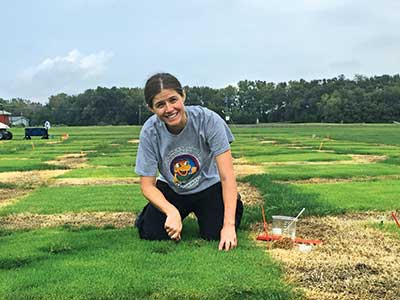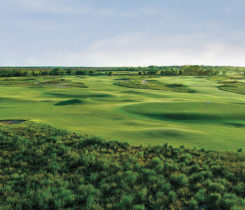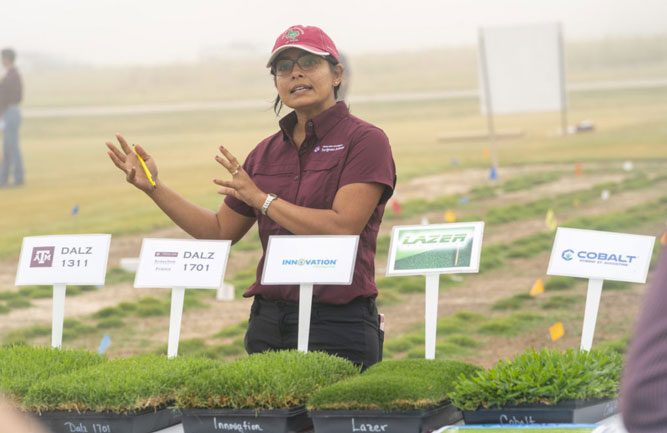Don’t get overmatched: Dispatch that large patch
Large patch is a fungal disease of zoysiagrass (Zoysia japonica, Z. matrella, Z. pacifica and various Zoysia hybrids) and several other warm-season grasses. This article focuses on the disease in zoysiagrass, which is becoming more popular in warm and transitional climates such as Kansas.
Zoysiagrass requires less water and is more tolerant of summer conditions than cool-season turf. Even better, zoysiagrass is not susceptible to some of the nasty diseases that can wipe out certain cool-season turfgrasses overnight, like gray leaf spot, which can decimate perennial ryegrass (Lolium perenne L.). It is much less susceptible to dollar spot and foliar Pythium than our cool-season grasses. Overall, zoysiagrass requires fewer inputs than cool-season grasses. Zoysiagrass is not susceptible to brown patch, caused by Rhizoctonia solani. But, it is susceptible to large patch, caused by… Rhizoctonia solani?
You read that right, brown patch of cool-season turfgrasses is caused by R. solani, and large patch is caused by R. solani. What’s the difference? They are caused by different subgroups of the species, called “anastomosis groups,” or AGs for short. Anastomosis group 2-2 IIIB is the main culprit for brown patch, and AG 2-2 LP is the culprit for large patch (sometimes called zoysia patch). Other subgroups of R. solani cause serious, yield-limiting diseases across the globe in important food crops such as wheat, potato, rice, sugar beets and many more.
Symptoms and timing
As noted above, large patch causes… large patches! More specifically, the disease leads to areas of tan to brown, thin turf that can be just a few feet across or up to 25 or more feet in diameter (Figure 2A). When disease is actively spreading, the patches often exhibit a distinctive bright orange margin (Figure 2B). Up close, you’ll see orange or tan leaf blades with rotten leaf sheaths (Figure 2C), and the sheaths easily pull off the plant. In our area, symptoms occur in fall (September-October) and spring (April-early June) when the weather is cool and wet, right when zoysia is either going into or coming out of dormancy.
Researchers have been studying large patch for decades, with important findings by U.S. and Japanese groups in the 1990s, including some work here at KSU. With increasing interest in zoysiagrass, several research groups have been working for five to 10 years to find solutions to this disease. Following are a few recent highlights, and there are other efforts as well.
Breeding
Resistant varieties are the best long-term solution to any disease, whether in turf, grapes, apples or wheat. That’s why plant pathologists and plant breeders work hand in hand on so many projects. For example, Ambika Chandra, Ph.D., and Dennis Genovesi, Ph.D. at Texas A&M are leading efforts to breed new zoysiagrass varieties with resistance to large patch. Our K-State group is working closely with our A&M colleagues, Aaron Patton, Ph.D., at Purdue, Mike Richardson, Ph.D., at the University of Arkansas, as well as others to screen breeding lines in a project funded by the USGA. It takes a long time to bring a new variety to market from the first cross.
Fungicides: the what, when, where, how
Currently, fungicides are a key element to large patch management. Each year, researchers test materials at various sites, and many of those studies are published. For example, in a quick search this week using the keyword “zoysiagrass” in Plant Disease Management Reports (PDMR, a peer-reviewed, academic publication), 26 studies popped up for large patch. Other studies have been published as longer articles in other academic journals, and some studies are not published but are still important preliminary data in the product development phase. University Extension faculty use published studies to help provide guidance for turfgrass managers. One example we use here in Kansas is the Chemical Control of Turfgrass Diseases publication, authored by Paul Vincelli, Ph.D., and Gregg Munshaw, Ph.D., at the University of Kentucky, along with Bruce Clarke, Ph.D., at Rutgers University. You can find that guide online here.
As noted in that publication, there are several mode of action groups (FRAC code groups) listed as effective for large patch with scores of 3 or 4 on their 4-point scale. Breaking it down into active ingredients, flutolanil, PCNB and triadimefon are listed as “consistently good to excellent control in published experiments,” while azoxystrobin, penthiopyrad, pyraclostrobin and triticonazole are listed as “good to excellent control in most experiments,” with tebuconazole intermediate between those two categories.
We at KSU like to do fungicide tests on inoculated plots using our buried-oats method because large patch is, well… patchy! However, we also conduct tests by mapping out known hot spots on golf courses. In Arkansas, researchers formally documented that patches often occur in the same area from season to season.
With such a strong seasonal component to the large patch life cycle, fungicide application timing is another key factor, getting at the “when” factor. At KSU, former Ph.D. student Ken Obasa examined the efficacy of three fungicides from three different mode of action groups (azoxystrobin, flutolanil and trifloxystrobin) using fall and spring timings and taking thatch temperatures averaged over the seven previous days. Our plots were fairway-height Meyer.
Prior Extension publications list a general guideline of applying when thatch temperatures decline to 70 to 75 degrees F. In our study, we generally observed reduced spring disease when prior fall fungicides were applied in a similar range of thatch temperatures from 64.0 degrees to 73.8 degrees F. However, there were a few exceptions. In two years, single fall applications of flutolanil, with thatch temperature 69.3 degrees or 70.9 degrees F, did not reduce disease. The same study looked at two
sequential fall applications at two-week intervals. The sequential applications did not enhance control compared to single applications for our timings. While fall applications have performed well in Kansas, we wanted to look at spring application timings as well.
For this experiment, we initiated our earliest applications at an early curative stage, when the zoysiagrass was starting to green up and symptoms were visible, which was in mid-April (thatch temperature 61 degrees F) in one year and early May (thatch temperature of 61.5 degrees F) in another year. We used the same three fungicides (azoxystrobin, flutolanil and trifloxystrobin) applied as single or sequential (two applications at a two-week interval). The two sequential spring applications did not enhance control compared to one application, but other intervals may perform differently. In general, spring applications were more effective when applied earlier in the season. Though the study was not set up to directly compare spring and fall applications, the spring applications generally were not as effective as the fall applications. However, because they were initiated at an early curative stage, we may have been too late to see the full potential of spring applications.

Figure 3B Burying the oats in thatch.
To explore the potential of early spring applications and to optimize timings, Lee Miller, Ph.D., at the University of Missouri, currently is looking at five-day average, 2-inch soil temperature thresholds of 50 degrees or 60 degrees F as possible triggers to initiate spring applications for large patch, with updates on his blog. We are looking forward to those results, which will be extremely helpful for fine-tuning the “when” of large patch applications.
Evaluating active ingredients is important, but it also is helpful to dive deeper and get into the nitty gritty of application methods. This is what we mean when we put the “where” and “how” into the what, when, where, how of fungicides. Detailed studies about nozzles, water rates and other “application technology” factors have been examined in other turf diseases, especially dollar spot, which is the “lab rat” of turf pathology. However, such studies for large patch were lacking until recently.
A group of researchers at University of Tennessee started to tackle this issue in detail, with results published in a scientific journal just a few months ago. They conducted growth chamber studies where four different fungicides from four mode of action groups (azoxystrobin, flutolanil, tebuconazole and chlorothalonil) were applied by the droplet onto leaves, leaf sheaths or stems in growth chamber plants. Stem and sheath applications were more effective than leaf applications, providing further
impetus to develop field application studies that precisely target the infection site. More work is needed in the field, but this study was an insightful peek into fungicide behavior at the droplet level.
Fertility: the who, what, when
Fertility is a key factor for many turfgrass diseases. Brown patch in cool-season grasses caused by that other group of R. solani is known to be triggered by high nitrogen. With that in mind, our former KSU Ph.D. student Ken Obasa looked at the influence of cultivation and fertilization timing in fairway-height Meyer zoysiagrass, with the help of funding from USGA, the Kansas Turf Foundation, the Heart of America Golf Course Superintendents Association and the Kansas Golf Course Association. Contrary to our expectations, spring and fall fertilization did not increase disease compared to summer, and in some cases the zoysiagrass was greener with the spring and fall applications. That study didn’t see increased or decreased disease with summer aerification plus topdressing, which occurred when disease symptoms were not apparent. However, there are reports of disease spreading if aerification is done while the disease is active.
Soon after the above work was completed, Lee Miller at the University of Missouri invited us to
collaborate with him on a follow-up study, with some funding from the USGA and local GCSAA chapters (Heart of America and Mississippi Valley). We looked at nitrogen source (ammonium sulfate, calcium nitrate and urea) and timing (spring/summer/fall). It was a great way to tag-team, train some new students with experience in turf diseases, and get data from multiple sites. Those results were summarized in Golfdom after publishing the study in a peer-reviewed journal.
In brief, the study found that spring and fall applications of nitrogen did not increase large patch severity, which means superintendents have some flexibility in their timing to reach other agronomic goals. In fact, spring nitrogen applications decreased large patch compared to summer applications at some of the sites. On the source factor, ammonium sulfate in spring led to lower large patch in some years, but this result was not consistent across our sites and years.
Beyond conventional fungicides and fertilizers
With increasing interest in alternative disease controls and increasing regulations in some places, a
team of researchers recently explored the potential of animal manure, sewage-based organic fertilizer and mustard seed meal in reducing large patch. The animal-waste product reduced disease by about half compared to non-treated controls. The researchers also examined effects of the treatments on microbial communities. In recent years, plant pathologists have used mass microbial DNA sequencing techniques to explore how the whole community of soil microbes (the “microbiome”) affects the dynamics of another R. solani that causes a root disease of wheat.
Have you ever seen large patches disappear on their own? Ever wonder if “good microbes” might be suppressing the bad ones? That could be the case, and future research might tell us more. You might have heard of studies looking at all the microbes in humans, called the “human microbiome.” Plant pathologists are now examining the “phytobiome” to learn how all microbes associated with plants are interconnected.
Making your plan with today’s tools
Though research on large patch in zoysiagrass is ongoing, superintendents right now have several fungicide active ingredients to choose from that have performed consistently. Fungicide timing will, of course, depend on your weather, so be sure to check with your local/regional experts. Recent work on fertilization has highlighted flexibility in nitrogen source and timing, and ammonium sulfate may be worth a look. Contrary to prior belief, spring and fall nitrogen has not increased large patch. Integrate fungicides and good fertility decisions with improved drainage, and avoid spreading disease by cultivating when disease is active.
There’s no perfect solution, but multiple effective practices can be combined. With ongoing breeding work, the hope is that someday, resistant cultivars will be a piece of your integrated disease management toolbox.
Acknowledgements
Thank you to the USGA, GCSAA and state/local chapters, groups and companies that support university research.
Photos Courtsey of Megan Kennelly and Jack Fry (Figure 3B)
References
Benelli, J.J., B.J. Horvath, A.R. Womac, B.H. Ownley, A.S.Windham, and J.C. Sorochan. 2017. Large patch (Rhizoctonia solani AG 2-2LP) severity on Japanese lawngrass (Zoysia japonica) influenced by fungicide and application target site. Crop Protection 106:23-28.












